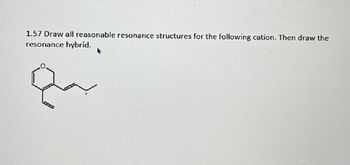
Organic Chemistry: A Guided Inquiry
2nd Edition
ISBN: 9780618974122
Author: Andrei Straumanis
Publisher: Cengage Learning
expand_more
expand_more
format_list_bulleted
Question

Transcribed Image Text:1.57 Draw all reasonable resonance structures for the following cation. Then draw the
resonance hybrid.
Expert Solution
This question has been solved!
Explore an expertly crafted, step-by-step solution for a thorough understanding of key concepts.
Step by stepSolved in 2 steps

Knowledge Booster
Similar questions
- 3.) Which of the following pairs are resonance structures of each other? (Circle all that apply) EN Sexarrow_forwardGive correct detailed Solution with explanation needed of all options..don't give Handwritten answer .don't use Ai for answering thisarrow_forward6. Good question. A molecule with zero formal charges on all atoms is drawn below. Identify which group of the periodic table each of the elements X, Y, Z, and A, belong to. A A A -X A A :Z-A Ÿ-Aarrow_forward
- 1.50 Which of the following species is a valid resonance structure of A? Use curved arrows to show how A is converted to any valid resonance structure. When a compound is not a valid resonance structure of A, explain why not. A Barrow_forwardPlease don't provide handwritten solution ....arrow_forward1. (a) Lewis diagrams may look different but represent the same bonding between atoms. Pair the Lewis diagrams A through D to each other. Explain your choice. Structure A Structure B Structure C H H H Structure D H H H- C -H H-C-HO-H H- -C-HO-H " H H H H- H H-O: -H H- ## H-C-H H H H D:H-C-Harrow_forward
- II. Problem solving. 1. Choose from each pair the one that will exhibit the given property to the greater extent a. bond polarity N-H b. net number of lone pairs NH3 c. bond length CI-F d. formal charge on N e. net number of lone pairs f. bond strength g. bond polarity h. bond length electronegativity i. j. formal charge on O NH4+ NH₂™ C-O H-CI N-N O H₂O 2. Draw the Lewis structures of the following then evaluate the formal charge a. PBr3 b. CH3OH B-F CH4 F-F NH3 NH₁+ C-N H-F N = N CI H3O+ C. NO₂¹¹arrow_forwardWhich of the following species is a valid resonance structure of A? Use curved arrows to show how A is converted to any valid resonance structure. When a compound is not a valid resonance structurc of A, explain why not. Provide steps and tips on what to look for to understand how to solve and apply to other problems.arrow_forwardDraw a single best Lewis structure for each molecule below. Assign non-zero formal charges to each atom. (a.) H2O2 (hydrogen peroxide) b) N2H4 (hydrazine) c) CH3SCN (methyl thiocyanate) d) CH2Cl2 (dichloromethane) e) SF6 (sulfur hexafluoride) f) PCl5 (phosphorus pentachloride) g) HClO4 (perchloric acid) h) BH3 (boron trihydride)arrow_forward
- Give correct detailed Solution with explanation needed . Don't give Handwritten answerarrow_forwardThe curved arrow notation introduced in Section 1.6 is a powerful method used by organic chemists to show the movement of electrons not only in resonance structures, but also in chemical reactions. Since each curved arrow shows the movement of two electrons, following the curved arrows illustrates what bonds are broken and formed in a reaction. Consider the following three-step process. (a) Add curved arrows in Step [1] to show the movement of electrons. (b) Use the curved arrows drawn in Step [2] to identify the structure of X. X is converted in Step [3] to phenol and HCl.arrow_forwardThe curved arrow notation introduced in Section 1.6 is a powerful method used by organic chemists to show the movement of electrons not only in resonance structures, but also in chemical reactions. Since each curved arrow shows the movement of two electrons, following the curved arrows illustrates what bonds are broken and formed in a reaction. Consider the following three-step process. (a) Add curved arrows in Step [1] to show the movement of electrons. (b) Use the curved arrows drawn in Step [2] to identify the structure of X. X is converted in Step [3] to phenol and HCl.arrow_forward
arrow_back_ios
SEE MORE QUESTIONS
arrow_forward_ios
Recommended textbooks for you
 Organic Chemistry: A Guided InquiryChemistryISBN:9780618974122Author:Andrei StraumanisPublisher:Cengage Learning
Organic Chemistry: A Guided InquiryChemistryISBN:9780618974122Author:Andrei StraumanisPublisher:Cengage Learning

Organic Chemistry: A Guided Inquiry
Chemistry
ISBN:9780618974122
Author:Andrei Straumanis
Publisher:Cengage Learning